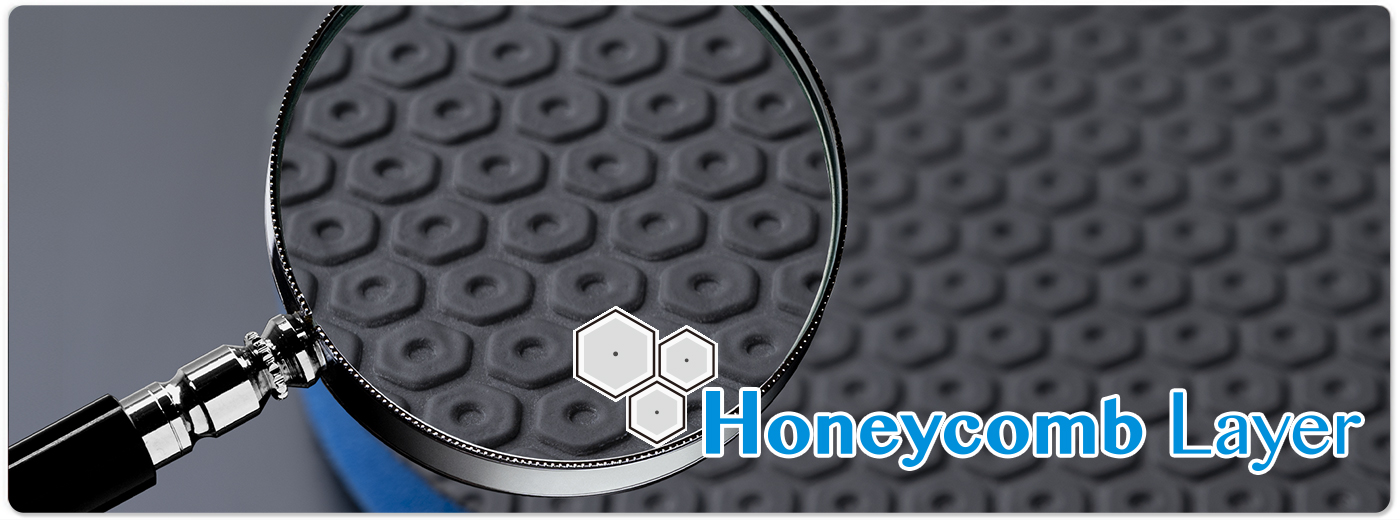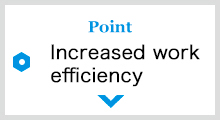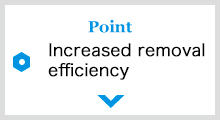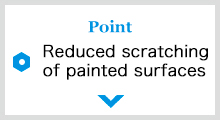- FE News»
- PPS News»
- Nov. 18, 2025
- Holiday Closing Notice [2025-2026]
- Jun. 23, 2025
- Notice of Specification Change for ECHELON Zen-Xero Series Maintenance Bags
- Oct. 31, 2024
- [News Release R-1020] Release of "ECHELON Zen-Xero DYNAMIX”
- May. 15, 2024
- [News Release R-1019] Release of "ECHELON Ver.3.0”
- Oct. 02, 2023
- [News Release R-1018]Compound that achieves a genuine finish Full Renewal of “KATANA” Series
Honeycomb Layer feature page
The Honeycomb Layer was patented by FE TRADE in 2016. Patent #5899335.
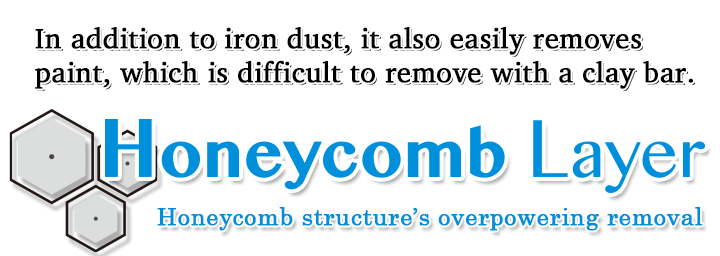
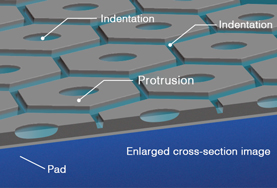
The Honeycomb Layer has a 3D honeycomb-structured surface of special rubber for removing contaminants. In addition to removing iron dust stuck to body panels and glass, it can also easily remove paint overspray which is difficult to remove with traditional clay bars. The patented honeycomb structure uses its many sides to efficiently capture contaminants for quick and easy work.
Video of Honeycomb Layer
Watch the Honeycomb Layer efficiently remove contaminants. You can also see it easily removing difficult-to-remove paint overspray in a specially filmed video.
It can efficiently remove a variety of contaminants.

Advantages of use
Rapidly increase the work efficiency of removing paint overspray, iron dust, and other contaminants
In addition to use with dual action polishers, the Honeycomb Layer also removes contaminants faster than traditional clay bars when used by hand, offering increased work efficiency. Furthermore, it leaves fewer scratches than clay bars, providing a beautiful finish.
Verification Test (1): Superior work efficiency
Experiment description
| Test subject | :Car hood panel (Toyota color 202) |
| Panel condition | :Parked near train tracks every day for half a year |
| Target area | :Approx. 1 square meter |
| Test environment | :Indoors, 23°C/44% humidity |
| Test description | :Work time required to remove contaminants until smooth to the touch |
Honeycomb Layer
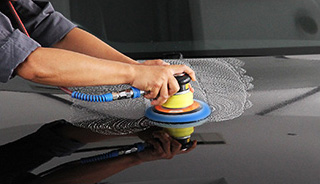
Body clay bar
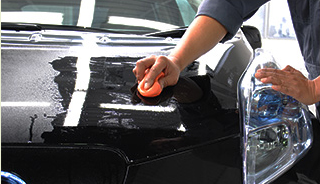

Verification Test (2): Superior removal efficiency
Experiment description
| Test subject | :Car hood panel (Toyota color 202) |
| Panel condition | : Heavily covered with iron dust and paint overspray |
| Target area | :Approx. 1.5 square meters |
| Test time | :3 minutes |
| Test description | :Degree of contaminant removal displayed as percentage * A 10mm square area is inspected under a microscope and the number of contaminants remaining is compared with the number before the test and used to calculate the percentage |

Verification Test (3): Reduced scratching of painted surfaces
Experiment description
| Test subject | :Car hood panel (Toyota color 202) |
| Panel condition | :Heavily covered with iron dust and paint overspray |
| Target area | :Approx. 1 square meter |
| Test description | :After removing contaminants, the amount of time required to erase the resultant scratches |

Here to go directly to the product page
Superior removal due to special structure
The honeycomb structure’s physical action produces excellent removal power and the special rubber material reduces damage

The honeycomb structure is made up of hexagonal assemblies arranged regularly which offer excellent functionality. It is currently patent pending in Japan and overseas. The multifaceted edges of the protruding hexagons
efficiently contact various shapes of adhering particles, offering excellent removal capabilities.
Each honeycomb structure is independent, allowing fluids to stay in the connected channels. The dual structure means fluids can also be stored in the central area.
The TRYPAD series’ special rubber material and honeycomb structure’s hexagonal grid and central dimples allow fluids such as smoothers and water to be stored efficiently during work, resulting in more stable contact with and minimal damage to the painted surface.
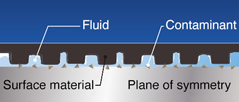
Contaminant removal mechanism
What makes TRYPAD so effective in removing contaminants and minimizing damage to painted surfaces is the special rubber material and grid structure. As the basic structure of TRYPAD, the rubber material effectively captures contaminants and removes them from painted surfaces. The grid structure then releases the removed contaminants constantly without allowing them to remain in the rubber. This is why TRYPAD withstands repeated use without suffering from the surface deterioration and work efficiency degradation.

-
[1]
A painted surface is usually covered with numerable contaminants stuck to it whether visible or invisibly tiny; they are varied in type, starting from iron dust, paint overspray, bug shells, pitch and so on. This revolutionary product, however, enables you to remove all of them at once in simple steps. 
-
[3]
The contaminants sucked to the rubber layer are bounced back by the rubber's elasticity to drain along the flowing smoother.
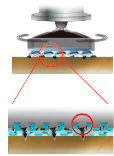
-
[2]
Attach a specialized buffing pad to a dual action polisher. Spray smoother over a working painted surface until thoroughly wet. Work on the surface to clean by lightly pressing the buffing pad over it. The special rubber layer topping the buffing pad sucks and effectively removes contaminants from the painted surface. 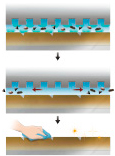
-
[4]
This drainage of contaminants takes place smoothly without hurting the painted surface because of the grid shape.
After these steps, use smoother to rinse or wipe the painted surface out to finish it into an untainted, flat and smooth condition.
Here to go directly to the product page
TRYPAD’s many uses
Starting with its Honeycomb Layer, the TRYPAD series can be used in many situations for the purpose of contaminant removal.
Auto detailing
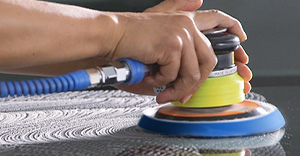
Removing contaminants before coating
Sheet metal paint
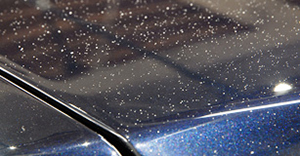
Removing paint overspray
TRYPAD’s many uses
The TRYPAD series has a wide lineup for various uses, all with the same purpose of removing contaminants. You can find one suitable for use in your industry or for your work process.
- Auto detailing
- Removing contaminants or paint overspray before body coating or finishing for delivery.
- Sheet metal painting and maintenance
- Removing paint overspray from scattering in a factory or from a painting accident; preparation before coating.
- Gas stations
- Contaminant removal as added value on car wash menu items or removal together with water-repellent treatment.
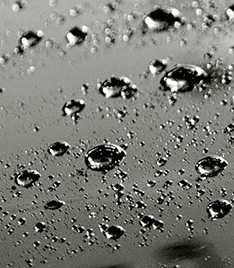
Revolutionary feel
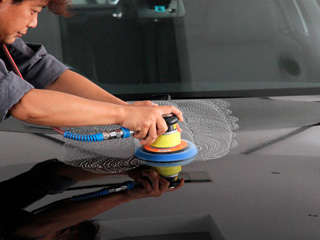
The first time I used Honeycomb Layer, I was surprised by how good it felt to use. Not only was it easier to use than normal clay pads for body panels, but it worked much more smoothly and quickly than traditional clay pads, too. In particular, when I used with a dual action polisher, it was able to remove iron dust, paint overspray, tar, and other contaminants all at once, allowing me to finish the tiresome removal step much more quickly than before.
Frequently asked questions
- How many vehicles can the Honeycomb Layer be used on?
- It can be used repeatedly on approximately 50 vehicles with a normal amount of contaminant coverage. Before and after use, simply wash the Honeycomb Layer’s special rubber pad to expel any contaminants and maintain the surface in a stable state.
- How should I store it?
- Generally, after using the Honeycomb Layer, it should be dried and returned to its package or stored at room temperature after removing any dirt. The rubber material is sensitive to temperature, so do not leave it inside a hot vehicle or under hot sunlight. If the rubber surface is exposed to temperatures above 40°C it will deteriorate irreversibly and become unusable. Please be careful.
- Do I have to use a smoother?
- No. Water can be used instead of a smoother without any problems. However, a smoother’s active agents will reduce the resistance between the rubber and the painted surface, making for smoother removal.
Here to go directly to the product page











































